|
|
|
Sort Order |
|
|
|
Items / Page
|
|
|
|
|
|
|
| Srl | Item |
| 1 |
ID:
133597
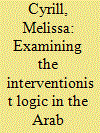

|
|
|
|
|
| Publication |
2014.
|
| Summary/Abstract |
At first glance, there was no coherent regional and international response to the transitions triggered in the Arab world since December 2010 as external players, both regional and international, had to confront with unceasing alarm the rapidity of change threatening to unravel in critical Arab states. However, as events in the region progressed, a pattern emerged to the external responses, one that was as predictive as it was differentiated. This was exemplified by the counter-revolutionary forces that were assembled against the transition in Bahrain on one hand, and the aggressively interventionist posture adopted towards Libya and Syria on the other. This inconsistency between activism and support for the supposedly democratic spirit of armed resistance groups, but inaction and silence towards the crushed non-violent public opposition elsewhere, clearly betrayed the interest-driven motivations of the external actors involved.
|
|
|
|
|
|
|
|
|
|
|
|
|
|
|
|
| 2 |
ID:
123388
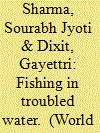

|
|
|
|
|
| Publication |
2013.
|
| Summary/Abstract |
Although there are positive signs of a big power playing an important and responsible role in a war ravaged country in its aftermath, China's foray in Afghanistan reflects that it is walking a diplomatic tightrope in Afghanistan. It is trying hard to maintain a silent but highly strategic presence in the country while at the same time managing its relations with other actors present in Afghanistan. However, as the date of US-NATO exit plan by the end of 2014 approaches; the politics between various domestic, regional, and international actors get surcharged.
|
|
|
|
|
|
|
|
|
|
|
|
|
|
|
|
| 3 |
ID:
123540
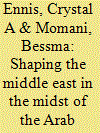

|
|
|
|
|
| Publication |
2013.
|
| Summary/Abstract |
While the Middle East and North Africa ( mena ) are undergoing rapid change, many domestic, regional and international actors are vying for space and influence as systems and customs evolve and adopt new forms. This paper characterises and compares the evolving foreign policy strategies of two such regional actors, Turkey and Saudi Arabia. It further assesses the motivations and activities of and challenges to Turkish and Saudi involvement throughout the region since the Arab uprisings. Ultimately these cases provide intriguing insight into the foreign policy purpose and methods of emerging states under conditions of uncertainty.
|
|
|
|
|
|
|
|
|
|
|
|
|
|
|
|
| 4 |
ID:
145369
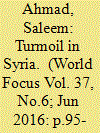

|
|
|
|
|
| Summary/Abstract |
In a word, Syria has become an arena for regional as well as outside actors; more significantly, these actors have the responsibility to find out peaceful resolution of the Syrian conflict, but these actors are playing bloody politics for geo-political interests and they have made Syrian conflict very complicated and there are less possibilities to resolve this problem, because mediators have also become the part of the problem and not part of the solution, indeed, they are also fighting a proxy war in Syria, and therefore, all the actors have high stakes in the regional politics of West Asia.
|
|
|
|
|
|
|
|
|
|
|
|
|
|
|
|
| 5 |
ID:
176235
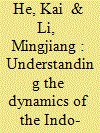

|
|
|
|
|
| Summary/Abstract |
As a geographical concept, ‘Indo-Pacific’ has existed for decades. As a political and strategic concept, it has since 2010 gradually become established in the foreign policy lexicon of some countries, especially Australia, India, Japan and the United States. However, China seems to be reluctant to identify itself as part of the Indo-Pacific; Chinese leaders believe that the US-led Indo-Pacific strategy aims to contain China's rise. While the battle between the two geographical concepts ‘Indo-Pacific’ and ‘Asia–Pacific’ may be fairly easily settled in the future, US–China strategic competition has just begun. Will the Indo-Pacific become a battlefield for US–China rivalry? How will China cope with the US ‘free and open Indo-Pacific’ (FOIP) strategy? How will other regional actors respond to the US–China strategic competition in the Indo-Pacific? What are the strategic implications of the ‘Indo-Pacific’ concept for regional order transformation? How will the Indo-Pacific be institutionalized, economically, politically and strategically? This article introduces the January 2020 special issue of International Affairs, which aims to address those questions, using both country-specific and regional perspectives. Seven articles focus on the policy responses of major players (Australia, China, India, Indonesia, Japan and ASEAN) to the US FOIP strategy and related US–China rivalry in the region. A further three articles examine the profound implications of Indo-Pacific dynamics for regional institution-building and for geopolitical and geo-economic architecture.
|
|
|
|
|
|
|
|
|
|
|
|
|
|
|
|
|
|
|
|
|